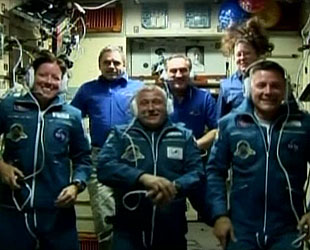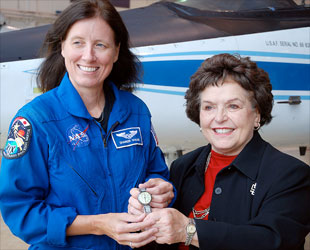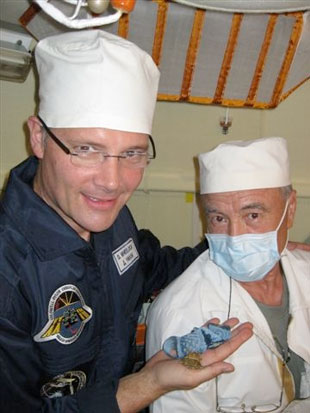June 17, 2010 — The watch that aviatrix Amelia Earhart wore while making history on two trans-Atlantic flights was brought onboard the International Space Station (ISS) on Thursday, 82 years to the day after its historic first flight. The timepiece was among a few mementos — including a medal of honor — that flew to orbit with the outpost's three newest crewmembers.
Earhart's watch arrived at the station onboard the Russian Soyuz TMA-19 spacecraft, which docked at the aft port of the Zvezda service module at 5:21 p.m. CDT as the two vehicles were, coincidentally, flying over the Atlantic.
The hatches between the two spacecraft were opened at 7:52 p.m., allowing NASA astronaut Shannon Walker, who was entrusted with the watch, and her fellow crew mates U.S. astronaut Doug Wheelock and Russian cosmonaut Fyodor Yurchikhin to join their three counterparts onboard the ISS to form the six-person Expedition 24 crew.
Walker's own arrival on the station made a bit of women's flight history of her own.
Launched 47 years after the first woman entered space and joining the station's crew just one day shy of the 27th anniversary of the first American woman in space, Walker — who is the world's 55th female spaceflier — became part of the largest contingent of women serving aboard a long duration mission with Tracy Caldwell Dyson.

Shannon Walker, Fyodor Yurchikhin and Doug Wheelock, front row, join the Expedition 24 crew on the station. (NASA TV) |
Time and time again
"Amelia crossed the Atlantic twice, once as a passenger and once as the pilot in command, flying solo, and she wore this watch both times," said Joan Kerwin, director of The Ninety-Nines, an international organization for women pilots.
Earhart became the first female trans-Atlantic passenger on June 17, 1928, departing Newfoundland and landing in Wales in the United Kingdom almost 21 hours later. Her historic solo flight began May 20, 1932 and touched down 15 hours later in Northern Ireland.
Before her disappearance in-flight on July 2, 1937, Earhart gifted the watch she wore on both trans-Atlantic trips to H. Gordon Selfridge Jr., who later gave it to Fay Gillis Wells, a charter member of The Ninety-Nines.
Kerwin, who acquired the timepiece from Wells at auction, presented it in October 2009 to Walker, a member of The Ninety-Nines, to fly to space.
"Amelia is such an icon with women in aviation and now with women in space. We are thrilled that Shannon is a Ninety-Nine and will be taking Amelia into space with her," Kerwin said last year.

NASA astronaut Shannon Walker and Joan Kerwin, the director of The Ninety-Nines, pose with Earhart's watch. (collectSPACE) |
Although the watch still runs, Walker won't use it to keep time but will keep it with her during the flight.
"I am very honored to take this watch," Walker said after accepting it from Kerwin, "because to me it represents the continuation of women in aviation and the field of aviation and how we continue to push boundaries and farther than ever before."
In addition to Earhart's watch, Walker selected a few other mementos to bring to the station, which relate to her being the first native Houstonian to fly in space. Houston, Texas hosts Johnson Space Center, where Mission Control and NASA's astronaut training facilities are based.
"[Houston has] a youth leadership council that works with the city and the mayor's office and I have the key to the city that I'm taking up for them," Walker said in a pre-flight interview with collectSPACE.com.
For her alma mater, Rice University in Houston, she has a plaque for their new space physics building.
For the University of Houston, where her late father was a physics professor and was instrumental in starting up the College of Natural Sciences and Mathematics, Walker has "a little poster."
"[The poster] shows some of the history from when that college started and shows my father's picture," she said.
Army Strong
Walker is not the only new arrival onboard the ISS to bring small mementos with historical and personal significance. Her fellow American on Soyuz TMA-19, Doug Wheelock is set to become the first active duty U.S. Army officer to command a spacecraft — the space station.
"The Army is really, really excited about this," Wheelock told collectSPACE.com.
A graduate of the United States Military Academy at West Point, Wheelock packed his 1983 class crest and a small guidon, or pennant, for his Company G3.

NASA astronaut Doug Wheelock, at left, displays Sergeant Lester Stone's Congressional Medal of Honor before its flight. (NASA) |
He also has Lester Stone's Congressional Medal of Honor, awarded for actions in the Vietnam War.
"He was killed in action but he is from my hometown area and as I was growing up, I participated in a lot of activities at the American Legion there that was named for him. He's sort of a hometown hero in that southern tier district of upstate New York," said Wheelock.
Sergeant Stone's mother gave the medal to Wheelock at a ceremony held in Harpursville, New York in April.
"It ties together my Army service and a tribute to those who have gone before us and then also kind of a tribute to my hometown as well," Wheelock said.
Have dog, will travel
For Soyuz TMA-19's commander Fyodor Yurchikhin it was important to bring photographs of his family, including his two daughters for whom he said he was flying some small items.
Like Walker and Wheelock, Yurchikhin also packed some mementos for his schools, but it was a gift from a teacher that he packed for himself.
"My dog, it is every time with me ever since 1976, when I got it in high school. My teacher gave me and my class members, he give us these dolls," said Yurchikhin of his stuffed toy that he flew on his previous two flights as well.
Yurchikhin and his dog, along with Walker and Wheelock will serve as part of the station's Expedition 24 crew until September when Dyson, Mikhail Kornienko and Alexander Skvortsov will depart and Expedition 25 will begin. Three new crewmates — Alexander Kaleri, Scott Kelly and Oleg Skripochka will arrive soon after.
